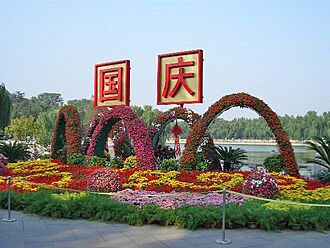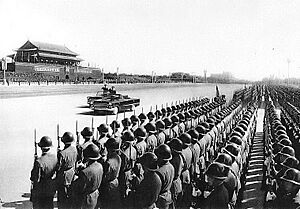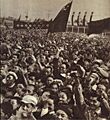National Day of the People's Republic of China facts for kids
Quick facts for kids National Day of the People's Republic of China中华人民共和国国庆节 |
|||||||||||||||||||||||||||
|---|---|---|---|---|---|---|---|---|---|---|---|---|---|---|---|---|---|---|---|---|---|---|---|---|---|---|---|

Flower garden at Beihai Park in 2004. The signboards read 国庆 (guóqìng; 'national celebration')
|
|||||||||||||||||||||||||||
| Also called | China Day, China's birthday, PRC Day, 10-1 | ||||||||||||||||||||||||||
| Observed by | People's Republic of China, including Hong Kong and Macau | ||||||||||||||||||||||||||
| Type | Historical, cultural, nationalist | ||||||||||||||||||||||||||
| Significance | The day of the proclamation of the People's Republic of China in 1949 | ||||||||||||||||||||||||||
| Celebrations | Festivities, including fireworks and concerts (a grand military parade every 10 years) | ||||||||||||||||||||||||||
| Date | 1 October | ||||||||||||||||||||||||||
| Next time | 1 October 2025 | ||||||||||||||||||||||||||
| Frequency | Annual | ||||||||||||||||||||||||||
| First time | 1 October 1949 | ||||||||||||||||||||||||||
| Chinese name | |||||||||||||||||||||||||||
| Simplified Chinese | 国庆节 | ||||||||||||||||||||||||||
| Traditional Chinese | 國慶節 | ||||||||||||||||||||||||||
| Literal meaning | national celebration holiday | ||||||||||||||||||||||||||
|
|||||||||||||||||||||||||||
| Portuguese name | |||||||||||||||||||||||||||
| Portuguese | Dia Nacional da República Popular da China | ||||||||||||||||||||||||||
National Day is a very important holiday in China. It is celebrated every year on October 1st. This day remembers when the People's Republic of China was officially created. This happened on October 1, 1949. On that day, Mao Zedong announced the new country.
Even though the main day is October 1st, people in China usually get a seven-day holiday. This long break is called Golden Week. During this time, there are many celebrations across the country. These include fireworks, concerts, and cultural events. Sometimes, a huge military parade is held in Beijing. This happens on special anniversaries, like every 10 years.
Contents
How National Day Started
The People's Republic of China was founded after a long period of conflict. The Chinese Communist Party (CCP) fought against the Kuomintang (KMT) government. This was known as the Chinese Civil War. After the war, the KMT government moved to the island of Taiwan.
On October 1, 1949, the new government was officially formed. A big ceremony took place in Tiananmen Square in Beijing. Mao Zedong, the leader of the CCP, made a speech. He announced the establishment of the People's Republic of China. The first public parade of the new army also happened that day.
Soon after, a leader named Ma Xulun suggested that October 1st should be the National Day. Other important leaders, including Mao Zedong, agreed. On December 2, 1949, it was officially decided. From 1950 onwards, October 1st would be the National Day of the People's Republic of China.
The first big National Day celebrations were held in Tiananmen Square on October 1, 1950. Over the years, the way the holiday is celebrated has changed. Sometimes there are smaller celebrations, and sometimes there are huge parades. For example, big military parades were held for the 35th, 50th, 60th, and 70th anniversaries of the country. The most recent grand celebration was in 2019 for the 70th anniversary.
National Celebrations
National Day kicks off the Golden Week holiday. This is a popular time for travel and family gatherings.
People celebrate National Day all over mainland China, Hong Kong, and Macau. The government organizes many fun events. You can see fireworks, concerts, sports, and cultural shows. Famous places like Tiananmen Square in Beijing are decorated. You might see large portraits of important leaders like Mao Zedong. Chinese people living in other countries also celebrate this special day.
Wreath-Laying Ceremony
A special ceremony used to be held on National Day. People would lay wreaths at the Monument to the People's Heroes. This monument honors the many Chinese people who died fighting for their country. Since 2014, this ceremony happens on September 30th. This day is now called Martyrs' Day. Important leaders attend this ceremony.
Flag-Raising Ceremony
Every National Day, a flag-raising ceremony takes place at Tiananmen Square. This is a very important event, especially in years when there isn't a big parade. The ceremony starts early in the morning. A special guard from the Beijing Garrison Honor Guard Battalion raises the flag. The National Marching Band of the PLA plays music.
Many people come to watch the ceremony in person. It is also shown live on TV and online. At the end of the ceremony, doves (birds) and colorful balloons are released into the sky.
Grand Military Parade

On special anniversaries, a huge military parade is held. Soldiers from the People's Liberation Army, People's Armed Police, and Militia march. Representatives from different parts of society also join. This includes groups like the Young Pioneers of China.
The parade takes place in Beijing on National Day morning. It is shown on TV across China and around the world. These parades were held every year from 1950 to 1959. Then they stopped until 1984. Since then, they have been held on important anniversaries, like in 1999 and 2009. The country's top leaders watch the parade.
Images for kids
-
Mao Zedong and Liu Shaoqi waving to the crowd on National Day 1950
-
Tiananmen Square, 2006 National Day of the PRC. The placard reads "Warmly celebrate the 57th anniversary of the founding of the People's Republic of China". The portrait is that of Sun Yat-sen.
See also
 In Spanish: Día Nacional de la República Popular China para niños
In Spanish: Día Nacional de la República Popular China para niños
- National Day
- History of the People's Republic of China
- 35th anniversary of the People's Republic of China
- 50th anniversary of the People's Republic of China
- 60th anniversary of the People's Republic of China
- 70th anniversary of the People's Republic of China














